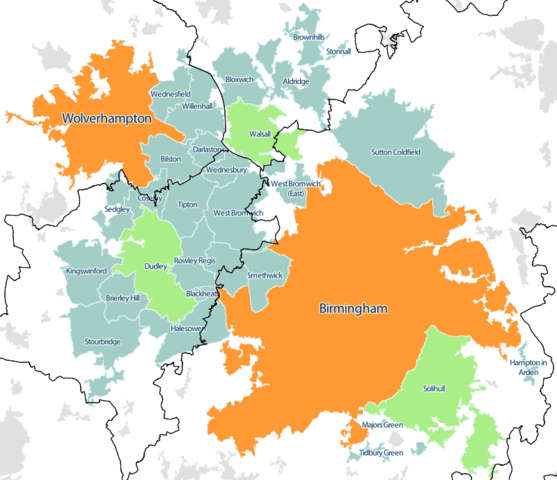Conurbation

|
| The West Midlands Built-Up Area as at the 2011 Census, with overlay of the 2007 Travel to Work Areas. Cities are highlighted in orange, and towns with local authority districts named after them highlighted in green. Source. |
The term ‘conurbation’ refers to: 'A region comprising a number of cities, large towns and other urban areas that, through population growth and physical expansion, have merged to form one continuous urban and industrially developed area.' Ref The HS2 London-West Midlands Environmental Statement, published by the Department for Transport in November 2013.
Spatial development glossary, European Conference of Ministers responsible for Spatial/Regional Planning (CEMAT), Territory and landscape, No. 2, published by Council of Europe Publishing in 2007, states: ‘A conurbation is an aggregation or continuous network of urban communities which have physically merged through population growth and expansion. It is a polycentric form of agglomeration. Physical proximity and continuity of built-up areas are a prerequisite for the definition of a conurbation, which does not exclude that interstitial open spaces may also exist. Conurbations generally developed during the industrial revolution when settlements were built up in areas with significant raw materials (especially mines) or along coastal strips (between the shore line and the mountains in the hinterland).’
[edit] Related articles on Designing Buildings
Featured articles and news
RTPI leader to become new CIOB Chief Executive Officer
Dr Victoria Hills MRTPI, FICE to take over after Caroline Gumble’s departure.
Social and affordable housing, a long term plan for delivery
The “Delivering a Decade of Renewal for Social and Affordable Housing” strategy sets out future path.
A change to adoptive architecture
Effects of global weather warming on architectural detailing, material choice and human interaction.
The proposed publicly owned and backed subsidiary of Homes England, to facilitate new homes.
How big is the problem and what can we do to mitigate the effects?
Overheating guidance and tools for building designers
A number of cool guides to help with the heat.
The UK's Modern Industrial Strategy: A 10 year plan
Previous consultation criticism, current key elements and general support with some persisting reservations.
Building Safety Regulator reforms
New roles, new staff and a new fast track service pave the way for a single construction regulator.
Architectural Technologist CPDs and Communications
CIAT CPD… and how you can do it!
Cooling centres and cool spaces
Managing extreme heat in cities by directing the public to places for heat stress relief and water sources.
Winter gardens: A brief history and warm variations
Extending the season with glass in different forms and terms.
Restoring Great Yarmouth's Winter Gardens
Transforming one of the least sustainable constructions imaginable.
Construction Skills Mission Board launch sector drive
Newly formed government and industry collaboration set strategy for recruiting an additional 100,000 construction workers a year.
New Architects Code comes into effect in September 2025
ARB Architects Code of Conduct and Practice available with ongoing consultation regarding guidance.
Welsh Skills Body (Medr) launches ambitious plan
The new skills body brings together funding and regulation of tertiary education and research for the devolved nation.
Paul Gandy FCIOB announced as next CIOB President
Former Tilbury Douglas CEO takes helm.
UK Infrastructure: A 10 Year Strategy. In brief with reactions
With the National Infrastructure and Service Transformation Authority (NISTA).






















